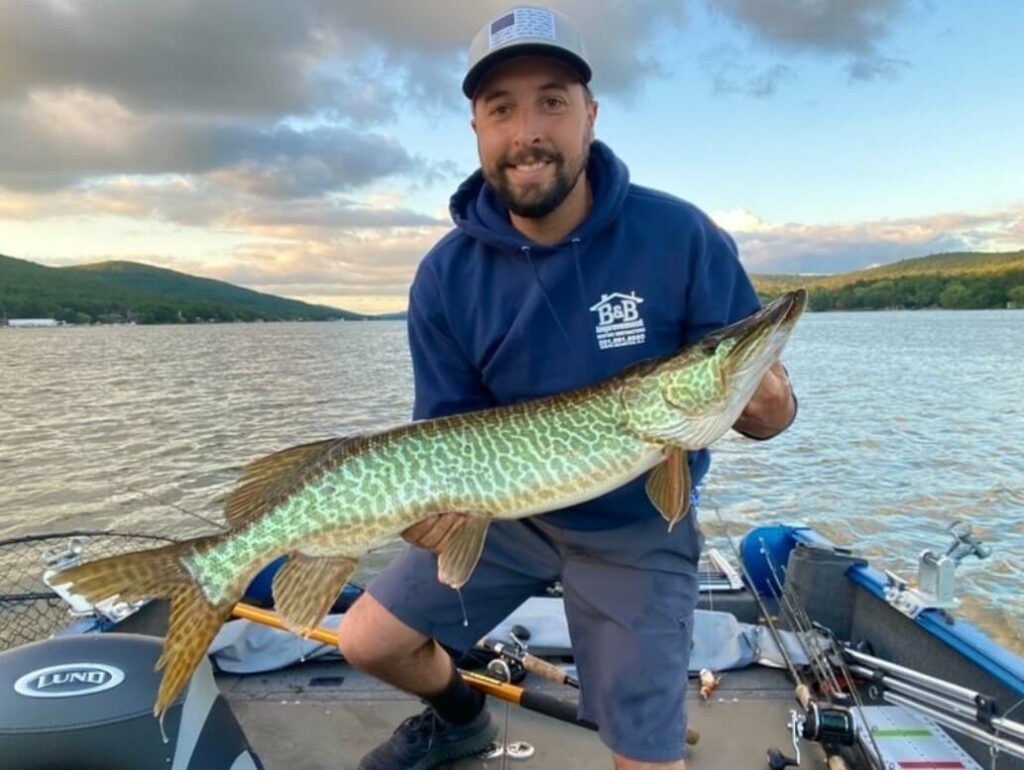General Facts
The tiger muskie is a hybrid resulting from the cross of a northern pike and a muskellunge. This beautifully marked fish has irregular narrow vertical dark markings on a light background with stripes merging onto the back in an interlocking pattern distinguishing it from the true-strain muskellunge. This aggressive sportfish is reported to be easier to catch than the pure-strain. The tiger muskie is sterile, therefore, alleviating any concerns for reproduction and allowing control of their numbers.
Where
The top tiger muskie waters are Greenwood Lake, Lake Hopatcong , Lake Musconetcong, and the Delaware River. Tiger fishing opportunities are also available at Manasquan Reservoir and Cooper River Park . Tigers, like their parent species, typically inhabit swallow water areas of lakes and rivers. They patrol outside weed edges, inside weed edges and hold under canopies of submerged vegetation. Tigers also hold off points and along weedy bars. In the heat of summer, when water temperatures approach 80°F, large tigers move to cooler, deeper water close to the thermocline, or near underwater springs and offshore humps.
When
Most tiger muskie fishing typically takes place during daylight. Tigers are reported to hit best under stable conditions. Action is sporadic until the end of May, but warming water in June brings some of the fastest fishing of the year. Tigers are aggressive throughout the summer and less active than true-strains in the fall. Tigers are willing to bite in winter through the ice, and there is a small following of avid tiger muskie ice fishermen.
How
Lure selection is similar to muskie-type lures i.e. bucktail spinners, crank baits and jerk baits. Tigers generally prefer smaller lures than the muskellunge. Tigers are often caught by bass anglers using typical bass lures such as spinner baits, crank baits and rattle traps.
In early season, cast small bucktail spinners in shallow coves. Retrieve slowly, keeping the lure a foot or two off the bottom. As the water warms, increase lure size and speed of retrieve. Once weedbeds develop, casting jerk baits and crank baits along outer edges is effective. Another summer pattern is trolling or casting crank baits along offshore bars. This technique also produces in mid-fall.
Tigers often occupy densely weeded areas where bass angling techniques are employed. Pitch or flip crank bait into a hole or pocket and twitch it a few times. On deeper flats, where weeds don’t reach the surface, work swallow running lures, such as a small Reef Hawg.
Stocking Summaries
- Tiger Muskie Stocking Summary, 2024 (pdf, 124kb)
- Tiger Muskie Stocking Summary, 2023 (pdf, 123kb)
- Tiger Muskie Stocking Summary, 2022 (pdf, 118kb)
- Tiger Muskie Stocking Summary, 2021
- Tiger Muskie Stocking Summary, 2019
- Tiger Muskie Stocking Summary, 2018
- Tiger Muskie Stocking Summary, 2017
- Tiger Muskie Stocking Summary, 2016
- Tiger Muskie Stocking Summary, 2015
- Tiger Muskie Stocking Summary, 2014
- Tiger Muskie Stocking Summary, 2013
- Tiger Muskie Stocking Summary, 2012
- Tiger Muskie Stocking Summary, 2011
Related Sportsmen’s Organization
Return to Fantastic Fishing in New Jersey
 Official Site of The State of New Jersey
Official Site of The State of New Jersey

